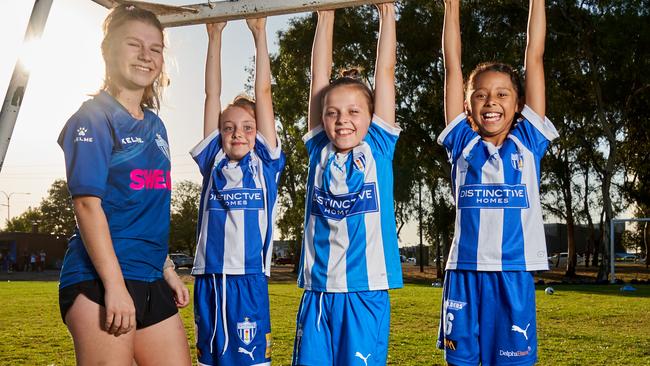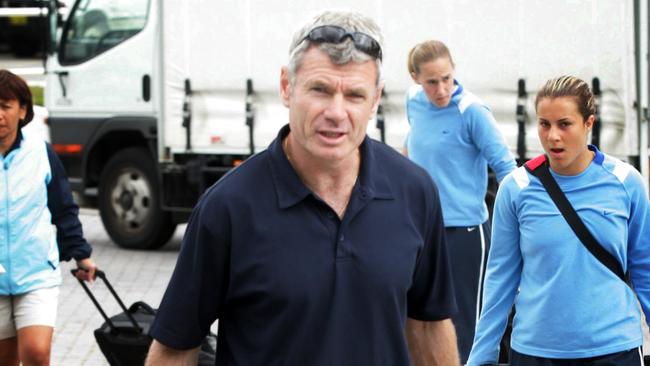The 2019 participation census data reveals women’s football in Australia has grown by 11 per cent over past 12 months
Australian women’s football is rapidly growing, picking up more than 500,000 participants in the past three years. The rapid increase in player numbers has also been seen in South Australia, according to new statistics.

Sport
Don't miss out on the headlines from Sport. Followed categories will be added to My News.
- Top young WNPL players to watch in 2020
- How to get the most out of your Advertiser digital subscription
Former Matildas coach Adrian Santrac believes the women’s soccer participation boom over the past 12 months has been fast-tracked because of increased media exposure across all female sports.
Women’s football has had an 11 per cent growth spurt since 2018, now boasting 159,893 participants according to the 2019 participation census data released by Football Federation Australia.
The latest statistics should attract FIFA’s attention as it prepares to announce the host of the 2023 Women’s World Cup mid year.
Australia has submitted a joint World Cup bid with New Zealand.
“Women’s sport has been big for a long time,’’ Santrac said.
Stream over 50 sports live & anytime on your TV or favourite device with KAYO SPORTS. The biggest Aussie sports and the best from overseas. Just $25/month. No lock-in contract. Get your 14-day free trial >

“The Hockeyroos have been hugely successful, the Matildas have been operating since before the ‘90s, basketball, volleyball, netball, the women’s sports have been there, but it’s only since AFLW has come in that people think now women’s sports exist.
“The media has jumped on board and the sports are well and truly out there, it’s no longer something that girls and women do occasionally, they have career pathways and it’s recognised on par with men’s sport.
MORE WOMEN’S FOOTBALL NEWS
West Adelaide’s Anna Pritchard wins Shirley Brown Medal for WNPL Player of the Year
Daniela Di Bartolo’s cheer squad for the WNPL preliminary final is an Adelaide City family affair
“Look at the women’s cricket, at the T20 World Cup final more than 86,000 were at the MCG.
“The amount of media exposure and the awareness has woken in effect 50 per cent of the population.
“If we win the World Cup bid it will put football in the mainstream spotlight again, it will create a greater awareness and (put it) in front of everybody.”

Santrac led the Matildas to the 2003 FIFA Women’s World Cup and the 2004 Athens Games where Australia held goal medallist United States to a 1-1 draw in Thessaloniki.
Santrac is in charge of West Adelaide’s Women’s NPL side for a second season after coaching their men’s side in the now defunct National Soccer League and winning NSL titles with Adelaide City.
Nearly two million Australians – 1,957,552 – are now participating in soccer.
That’s an increase of almost 25 per cent from 1,301,244 seven years ago.
Apart from the 11 per cent growth in women’s football participation over the past 12 months, statistics proved there is a six per cent overall growth.
Santrac said he had seen a dramatic improvement in the same since he was fully immersed at the top end of women’s football as the MiniRoos programs for kids aged up to 11 experienced the biggest growth.
Almost 50,000 children are registered as MiniRoos, where SA has had a nine per cent growth among girls aged four to 11, social football has grown 33 per cent and futsal 24 per cent among females.

“Player development is a big difference, players are technically better today than (when) I had the Matildas,’’ Santrac said.
“While we had some technically proficient players across the board, now one of the big areas is you can pick players on their technical ability.
“Back then players would be picked on their athletic and physical capability, and if they were good technically that would stand out.
“Today it’s a combination, it’s the holistic strength of a footballer; you’re now looking at them and measuring them in the same way you measure guys, the whole package of a footballer and that they’ve got.
“They’re better footballers all around.”
Football’s national growth total participation
2016: 1.30 million
2017: 1.63 million
2018: 1.85 million
2019: 1.96 million
Women and girls growth snapshots
Total 2019: 156,893
SA: 6859
Outdoor: 119,037
MiniRoos: 49,950
Youth: 40,470
Senior: 28,617
Originally published as The 2019 participation census data reveals women’s football in Australia has grown by 11 per cent over past 12 months


